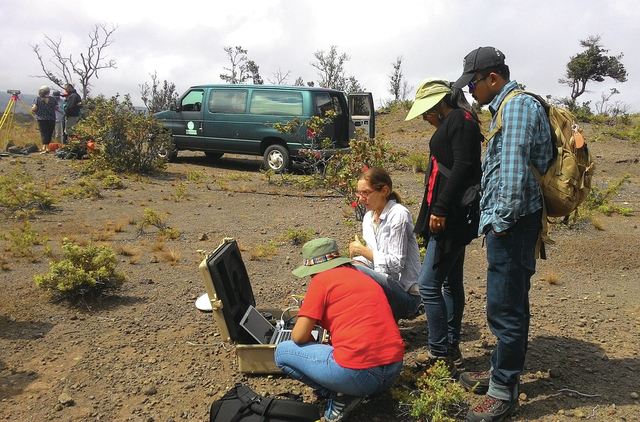In 1902, visionary geologist Thomas Jaggar — founder of the Hawaiian Volcano Observatory — traveled to the Caribbean Island of Martinique, where he witnessed first-hand the aftermath of the deadly Mount Pelee eruption. More than 30,000 people had been killed
In 1902, visionary geologist Thomas Jaggar — founder of the Hawaiian Volcano Observatory — traveled to the Caribbean Island of Martinique, where he witnessed first-hand the aftermath of the deadly Mount Pelee eruption. More than 30,000 people had been killed by the eruption, and the devastation he observed contributed to Jaggar’s lifelong work to “protect life and property on the basis of sound scientific achievement.”
Today, more than 800 million people — 10 percent of the world’s population — live within 62 miles of active, potentially deadly volcanoes. In the last four centuries, nearly 280,000 people have been killed by volcanic activity, according to a recent book commissioned by the United Nations Office for Disaster Risk Reduction for the 2015 Global Assessment Report.
Despite this, many nations around the world lack resources to properly train and grow teams of experts in volcano monitoring, eruption response, and hazard assessment—key skills required to help societies prosper in volcanically active areas.
Since 1990, the University of Hawaii at Hilo’s Center for the Study of Active Volcanoes, the U.S. Geological Survey’s Hawaiian Volcano Observatory, and the USGS/U.S. Agency for International Development (USAID) Volcano Disaster Assistance Program have sponsored an annual eight-week International Training Program in the United States to help address this global skill gap.
Hawaii Island is a perfect location to host the class, as our volcanoes are accessible, active, and home to some of the world’s experts in volcano monitoring.
The course brings together scientists and technicians from around the globe to learn about and practice volcano monitoring, eruption forecasting, hazard communication, and other critical topics shared by leading volcano science professionals. This year, a dozen scientists from China, South Korea, Indonesia, the Philippines, Costa Rica, Nicaragua, Peru, and Chile participated in classes and fieldwork at Kilauea and elsewhere on the island.
The training curriculum spans the gamut, from theory to practice, and includes spectroscopic methods of measuring volcanic gas, satellite remote sensing, how to install and maintain seismometers and solar panels, and more. Students and instructors spend time in the classroom, at computers, in labs, and in the field, including experience working on/around Kilauea Volcano’s active lava flow.
After their time in Hawaii, class participants move on to the Pacific Northwest, where they are hosted by the USGS Cascades Volcano Observatory. Their focus of learning there turns to explosive stratovolcanoes, like Mount St. Helens and Mount Hood, which are similar to the volcanoes of most concern in their home countries.
All told, after 26 years and more than 200 students completing the curricula, organizers, instructors, and participants agree that the training does contribute to lessening volcanic risk throughout the world. And, in addition to practical skills, course participants make lifelong friendships and develop professional relationships with kindred spirits. Such networking can pay great dividends when volcanoes become restless and help from afar might be needed.
Although the training does leave time for learning about local foods, culture, and recreational opportunities (surfing is one of the popular after-class activities in Hawaii), the course is serious business. In some of the participants’ home countries, many tens of thousands of people live in the shadows of dangerous and under-monitored volcanoes. Imagine the responsibility felt by these international students upon returning home with their new skills and knowledge.
Volcanology is a fast-changing, international science with an increasing number of professionals dedicated to understanding how volcanoes work. HVO is pleased to be part of a valuable training program dedicated to saving lives. Hopefully, Jaggar would be proud.
For more information on the course, visit https://hilo.hawaii.edu/~csav/international/. For more information about the USGS/USAID Volcano Disaster Assistance Program, visit https://volcanoes.usgs.gov/vdap/.
Volcano Watch is a weekly article and activity update written by U.S. Geological Survey Hawaiian Volcano Observatory scientists and affiliates.
Volcano
Activity Updates
Kilauea continues to erupt at its summit and East Rift Zone. During the past week, the summit lava lake level varied between about 85-135 feet below the vent rim within Halemaumau Crater. On the East Rift Zone, the “61g” flow continued to advance down the south flank of the volcano and flow into the ocean. The lava flow does not pose an immediate threat to nearby communities.
Mauna Loa is not erupting. In the past week, earthquakes have occurred mostly in the south caldera and upper Southwest Rift Zone at depths less than 3 miles, with the overall seismicity rate about the same as last week, but still elevated relative to the long-term background rate. Global Positioning System (GPS) measurements show deformation related to inflation of a magma reservoir beneath the summit and upper Southwest Rift Zone, with inflation occurring mainly in the southwestern part of the magma storage complex.
One earthquake was reported felt on the Island of Hawaii this past week. On Saturday, July 30, at 11:12 a.m., a magnitude-3.2 earthquake occurred 7.3 miles southeast of Mauna Kea’s summit at a depth of 13 miles.
Visit the HVO website (https://hvo.wr.usgs.gov) for past Volcano Watch articles, Kilauea daily eruption updates, Mauna Loa weekly updates, volcano photos, recent earthquakes info, and more; call for summary updates at 967-8862 (Kilauea) or 967-8866 (Mauna Loa); email questions to askHVO@usgs.gov.



